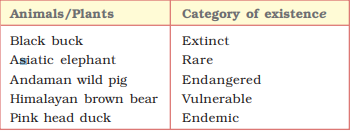Table of Contents


Narak! My Lord, you are the creator of music in the world of Lepchas Oh Narak! My Lord, let me dedicate myself to you Let me gather your music from the springs, the rivers, the mountains, the forests, the insects and the animals Let me gather your music from the sweet breeze and offer it to you
Source: Lepcha folk song from northern part of West Bengal
We share this planet with millions of other living beings, starting from micro-organisms and bacteria, lichens to banyan trees, elephants and blue whales. This entire habitat that we live in has immense biodiversity. We humans along with all living organisms form a complex web of ecological system in which we are only a part and very much dependent on this system for our own existence. For example, the plants, animals and micro-organisms re-create the quality of the air we breathe, the water we drink and the soil that produces our food without which we cannot survive. Forests play a key role in the ecological system as these are also the primary producers on which all other living beings depend.
Biodiversity or Biological Diversity is immensely rich in wildlife and cultivated species, diverse in form and function but closely integrated in a system through multiple network of interdependencies.
Flora and Fauna in India
If you look around, you will be able to find that there are some animals and plants which are unique in your area. In fact, India is one of the world’s richest countries in terms of its vast array of biological diversity. This is possibly twice or thrice the number yet to be discovered. You have already studied in detail about the extent and variety of forest and wildlife resources in India. You may have realised the importance of these resources in our daily life. These diverse flora and fauna are so well integrated in our daily life that we take these for granted. But, lately, they are under great stress mainy due to insensitivity to our environment.
Find out stories prevalent in your region which are about the harmonious relationship between human beings and nature.
Some estimates suggest that at least 10 per cent of India’s recorded wild flora and 20 per cent of its mammals are on the threatened list. Many of these would now be categorised as ‘critical’, that is on the verge of extinction like the cheetah, pink-headed duck, mountain quail, forest spotted owlet, and plants like madhuca insignis (a wild variety of mahua) and hubbardia heptaneuron,(a species of grass). In fact, no one can say how many species may have already been lost. Today, we only talk of the larger and more visible animals and plants that have become extinct but what about smaller animals like insects and plants?
Vanishing Forests
The dimensions of deforestation in India are staggering. The forest and tree cover in the country is estimated at 79.42 million hectare, which is 24.16 per cent of the total geographical area (dense forest 12.2 per cent; open forest 9.14 per cent; and mangrove 0.14 per cent). According to the State of Forest Report (2015), the dense forest cover has increased by 3,775 sq km since 2013. However, this apparent increase in the forest cover is due to conservation measures, management interventions and plantation, etc., by different agencies.
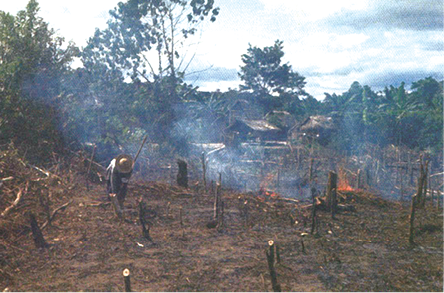
Fig. 2.1
Let us now understand the different categories of existing plants and animal species. Based on the International Union for Conservation of Nature and Natural Resources (IUCN), we can classify as follows–
Normal Species: Species whose population levels are considered to be normal for
their survival, such as cattle, sal, pine, rodents, etc.
Endangered Species: These are species which are in danger of extinction. The survival of such species is difficult if the negative factors that have led to a decline in their population continue to operate. The examples of such species are black buck, crocodile, Indian wild ass, Indian rhino, lion tailed macaque, sangai (brow anter deer in Manipur), etc.
Vulnerable Species: These are species whose population has declined to levels from where it is likely to move into the endangered category in the near future if the negative factors continue to operate. The examples of such species are blue sheep, Asiatic elephant, Gangetic dolphin, etc.
Rare Species: Species with small population may move into the endangered or vulnerable category if the negative factors affecting them continue to operate. The examples of such species are the Himalayan brown bear, wild Asiatic buffalo, desert fox and hornbill, etc.
Endemic Species: These are species which are only found in some particular areas usually isolated by natural or geographical barriers. Examples of such species are the Andaman teal, Nicobar pigeon, Andaman wild pig, mithun in Arunachal Pradesh.
Extinct Species: These are species which are not found after searches of known or likely areas where they may occur. A species may be extinct from a local area, region, country, continent or the entire earth. Examples of such species are the Asiatic cheetah, pink head duck.
Asiatic Cheetah: where did they go?
The world’s fastest land mammal, the cheetah (Acinonyx jubantus), is a unique and specialised member of the cat family and can move at the speed of 112 km./hr. The cheetah is often mistaken for a leopard. Its distinguishing marks are the long teardropshaped lines on each side of the nose from the corner of its eyes to its mouth. Prior to the 20th century, cheetahs were widely distributed throughout Africa and Asia. Today, the Asian cheetah is nearly extinct due to a decline of available habitat and prey. The species was declared extinct in India long back in 1952.
What are the negative factors that cause such fearful depletion of the flora and fauna?
If you look around, you will be able to find out how we have transformed nature into a resource obtaining directly and indirectly from the forests and wildlife – wood, barks, leaves, rubber, medicines, dyes, food, fuel, fodder, manure, etc. So it is we ourselves who have depleted our forests and wildlife. The greatest damage inflicted on Indian forests was during the colonial period due to the expansion of the railways, agriculture, commercial and scientific forestry and mining activities. Even after Independence, agricultural expansion continues to be one of the major causes of depletion of forest resources. Between 1951 and 1980, according to the Forest Survey of India, over 26,200 sq. km. of forest area was converted into agricultural land all over India. Substantial parts of the tribal belts, especially in the northeastern and central India, have been deforested or degraded by shifting cultivation (jhum), a type of ‘slash and burn’ agriculture.
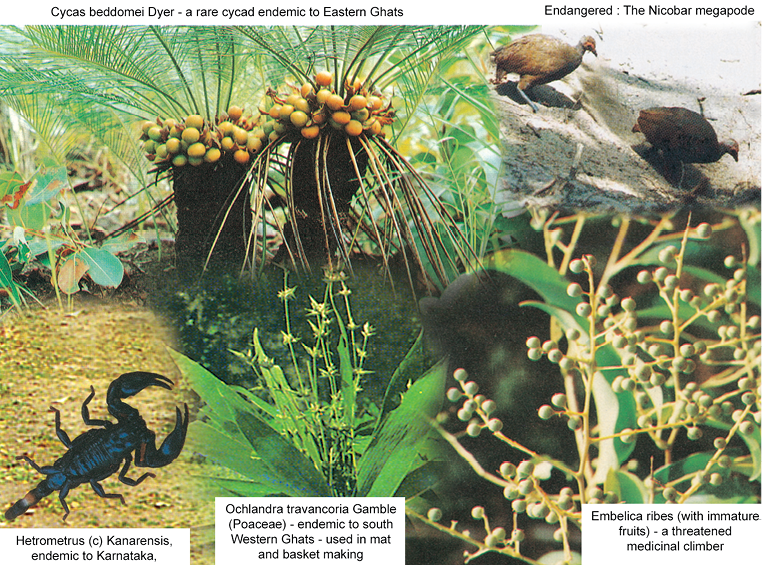
Fig. 2.2: A few extinct, rare and endangered species
Are colonial forest policies to be blamed?
Some of our environmental activists say that the promotion of a few favoured species, in many parts of India, has been carried through the ironically-termed “enrichment plantation”, in which a single commercially valuable species was extensively planted and other species eliminated. For instance, teak monoculture has damaged the natural forest in South India and Chir Pine (Pinus roxburghii) plantations in the Himalayas have replaced the Himalayan oak (Quercius spp.) and Rhododendron forests.
Large-scale development projects have also contributed significantly to the loss of forests. Since 1951, over 5,000 sq km of forest was cleared for river valley projects. Clearing of forests is still continuing with projects like the Narmada Sagar Project in Madhya Pradesh, which would inundate 40,000 hectares of forest. Mining is another important factor behind deforestation. The Buxa Tiger Reserve in West Bengal is seriously threatened by the ongoing dolomite mining. It has disturbed the natural habitat of many species and blocked the migration route of several others, including the great Indian elephant.
Many foresters and environmentalists hold the view that the greatest degrading factors behind the depletion of forest resources are grazing and fuel-wood collection. Though, there may be some substance in their argument, yet, the fact remains that a substantial part of the fuel-fodder demand is met by lopping rather than by felling entire trees. The forest ecosystems are repositories of some of the country’s most valuable forest products, minerals and other resources that meet the demands of the rapidly expanding industrial-urban economy. These protected areas, thus mean different things to different people, and therein lies the fertile ground
for conflicts.
Habitat destruction, hunting, poaching, over-exploitation, environmental pollution, poisoning and forest fires are factors, which have led to the decline in India’s biodiversity. Other important causes of environmental destruction are unequal access, inequitable consumption of resources and differential sharing of responsibility for environmental well-being. Over-population in third world countries is often cited as the cause of environmental degradation. However, an average American consumes 40 times more resources than an average Somalian. Similarly, the richest five per cent of Indian society probably cause more ecological damage because of the amount they consume than the poorest 25 per cent. The former shares minimum responsibilities for environmental well-being. The question is: who is consuming what, from where and how much?
The Himalayan Yew in trouble
The Himalayan Yew (Taxus wallachiana) is a medicinal plant found in various parts of Himachal Pradesh and Arunachal Pradesh. A chemical compound called ‘taxol’ is extracted from the bark, needles, twigs and roots of this tree, and it has been successfully used to treat some cancers – the drug is now the biggest selling anti-cancer drug in the world. The species is under great threat due to over-exploitation. In the last one decade, thousands of yew trees have dried up in various parts of Himachal Pradesh and Arunachal Pradesh.

The destruction of forests and wildlife is not just a biological issue. The biological loss is strongly correlated with the loss of cultural diversity. Such losses have increasingly marginalised and impoverished many indigenous and other forest-dependent communities, who directly depend on various components of the forest and wildlife for food, drink, medicine, culture, spirituality, etc. Within the poor, women are affected more than men. In many societies, women bear the major responsibility of collection of fuel, fodder, water and other basic subsistence needs. As these resources are depleted, the drudgery of women increases and sometimes they have to walk for more than 10 km to collect these resources. This causes serious health problems for women and negligence of home and children because of the increased hours of work, which often has serious social implications. The indirect impact of degradation such as severe drought or deforestation-induced floods, etc. also hits the poor the hardest. Poverty in these cases is a direct outcome of environmental destruction. Therefore, forest and wildlife, are vital to the quality of life and environment in the subcontinent. It is imperative to adapt to sound forest and wildlife conservation strategies.
Have you noticed any activity which leads to the loss of biodiversity around you? Write a note on it and suggest some measures to prevent it.
Do you know that over half of India’s natural forests are gone, one-third of its wetlands drained out, 70 per cent of its surface water bodies polluted, 40 per cent of its mangroves wiped out, and with continued hunting and trade of wild animals and commercially valuable plants, thousands of plant and animal species are heading towards extinction?
Conservation of Forest and Wildlife in India
Conservation in the background of rapid decline in wildlife population and forestry has become essential. But why do we need to conserve our forests and wildlife? Conservation preserves the ecological diversity and our life support systems – water, air and soil. It also preserves the genetic diversity of plants and animals for better growth of species and breeding. For example, in agriculture, we are still dependent on traditional crop varieties. Fisheries too are heavily dependent on the maintenance of aquatic biodiversity.
In the 1960s and 1970s, conservationists demanded a national wildlife protection programme. The Indian Wildlife (Protection) Act was implemented in 1972, with various provisions for protecting habitats. An all-India list of protected species was also published. The thrust of the programme was towards protecting the remaining population of certain endangered species by banning hunting, giving legal protection to their habitats, and restricting trade in wildlife. Subsequently, central and many state governments established national parks and wildlife sanctuaries about which you have already studied. The central government also announced several projects for protecting specific animals, which were gravely threatened, including the tiger, the one-horned rhinoceros, the Kashmir stag or hangul, three types of crocodiles – fresh water crocodile, saltwater crocodile and the Gharial, the Asiatic lion, and others. Most recently, the Indian elephant, black buck (chinkara), the great Indian bustard (godawan) and the snow leopard, etc. have been given full or partial legal protection against hunting and trade throughout India.
Project Tiger
Tiger is one of the key wildlife species in the faunal web. In 1973, the authorities realised that the tiger population had dwindled to 1,827 from an estimated 55,000 at the turn of the century. The major threats to tiger population are numerous, such as poaching for trade, shrinking habitat, depletion of prey base species, growing human population, etc. The trade of tiger skins and the use of their bones in traditional medicines, especially in the Asian countries left the tiger population on the verge of extinction. Since India and Nepal provide habitat to about two-thirds of the surviving tiger population in the world, these two nations became prime targets for poaching and illegal trading.
“Project Tiger”, one of the well-publicised wildlife campaigns in the world, was launched in 1973. Tiger conservation has been viewed not only as an effort to save an endangered species, but with equal importance as a means of preserving biotypes of sizeable magnitude. Corbett National Park in Uttarakhand, Sunderbans National Park in West Bengal, Bandhavgarh National Park in Madhya Pradesh, Sariska Wildlife Sanctuary in Rajasthan, Manas Tiger Reserve in Assam and Periyar Tiger Reserve in Kerala are some of the tiger reserves of India.
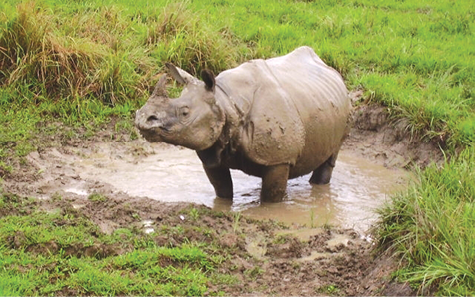
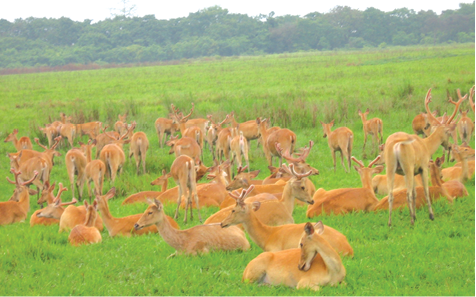
Fig. 2.4: Rhino and deer in Kaziranga National Park
The conservation projects are now focusing on biodiversity rather than on a few of its components. There is now a more intensive search for different conservation measures. Increasingly, even insects are beginning to find a place in conservation planning. In the notification under Wildlife Act of 1980 and 1986, several hundred butterflies, moths, beetles, and one dragonfly have been added to the list of protected species. In 1991, for the first time plants were also added to the list, starting with six species.
Collect more information on the wildlife sanctuaries and national parks of India and cite their locations on the map of India
Types and Distribution of Forest and Wildlife Resources
Even if we want to conserve our vast forest and wildlife resources, it is rather difficult to manage, control and regulate them. In India, much of its forest and wildlife resources are either owned or managed by the government through the Forest Department or other government departments. These are classified under the following categories.
(i) Reserved Forests: More than half of the total forest land has been declared reserved forests. Reserved forests are regarded as the most valuable as far as the conservation of forest and wildlife resources are concerned.
(ii) Protected Forests: Almost one-third of the total forest area is protected forest, as declared by the Forest Department. This forest land are protected from any further depletion.
(iii) Unclassed Forests: These are other forests and wastelands belonging to
both government and private individuals and communities.
Reserved and protected forests are also referred to as permanent forest estates maintained for the purpose of producing timber and other forest produce, and for protective reasons. Madhya Pradesh has the largest area under permanent forests, constituting 75 per cent of its total forest area. Jammu and Kashmir, Andhra Pradesh, Uttarakhand, Kerala, Tamil Nadu, West Bengal, and Maharashtra have large percentages of reserved forests of its total forest area whereas Bihar, Haryana, Punjab, Himachal Pradesh, Odisha and Rajasthan have a bulk of it under protected forests. All North-eastern states and parts of Gujarat have a very high percentage of their forests as unclassed forests managed by local communities.

Can you find out the reasons for the above mentioned problems?
Community and Conservation
Conservation strategies are not new in our country. We often ignore that in India, forests are also home to some of the traditional communities. In some areas of India, local communities are struggling to conserve these habitats along with government officials, recognising that only this will secure their own long-term livelihood. In Sariska Tiger Reserve, Rajasthan, villagers have fought against mining by citing the Wildlife Protection Act. In many areas, villagers themselves are protecting habitats and explicitly rejecting government involvement. The inhabitants of five villages in the Alwar district of Rajasthan have declared 1,200 hectares of forest as the Bhairodev Dakav ‘Sonchuri’, declaring their own set of rules and regulations which do not allow hunting, and are protecting the wildlife against any outside encroachments.
The famous Chipko movement in the Himalayas has not only successfully resisted deforestation in several areas but has also shown that community afforestation with indigenous species can be enormously successful. Attempts to revive the traditional conservation methods or developing new methods of ecological farming are now widespread. Farmers and citizen’s groups like the Beej Bachao Andolan in Tehri and Navdanya have shown that adequate levels of diversified crop production without the use of synthetic chemicals are possible and economically viable.
The clear lesson from the dynamics of both environmental destruction and reconstruction in India is that local communities everywhere have to be involved in some kind of natural resource management. But there is still a long way to go before local communities are at the centre-stage in decision-making. Accept only those economic or developmental activities, that are people centric, environment-friendly and economically rewarding.
Sacred groves - a wealth of diverse and rare species
Nature worship is an age old tribal belief based on the premise that all creations of nature have to be protected. Such beliefs have preserved several virgin forests in pristine form called Sacred Groves (the forests of God and Goddesses). These patches of forest or parts of large forests have been left untouched by the local people and any interference with them is banned.
Certain societies revere a particular tree which they have preserved from time immemorial. The Mundas and the Santhal of Chota Nagpur region worship mahua (Bassia latifolia) and kadamba (Anthocaphalus cadamba) trees, and the tribals of Odisha and Bihar worship the tamarind (Tamarindus indica) and mango (Mangifera indica) trees during weddings. To many of us, peepal and banyan trees are considered sacred.
Indian society comprises several cultures, each with its own set of traditional methods of conserving nature and its creations. Sacred qualities are often ascribed to springs, mountain peaks, plants and animals which are closely protected. You will find troops of macaques and langurs around many temples. They are fed daily and treated as a part of temple devotees. In and around Bishnoi villages in Rajasthan, herds of blackbuck, (chinkara), nilgai and peacocks can be seen as an integral part of the community and nobody harms them.
Write a short essay on any practices which you may have observed and practised in your everyday lives that conserve and protect the environment around you.
1. Multiple choice questions.
(i) Which of these statements is not a valid reason for the depletion of flora and fauna?
(a) Agricultural expansion.
(b) Large scale developmental projects.
(c) Grazing and fuel wood collection.
(d) Rapid industrialisation and urbanisation.
(ii) Which of the following conservation strategies do not directly involve community participation?
(a) Joint forest management (c) Chipko Movement
(b) Beej Bachao Andolan (d) Demarcation of Wildlife sanctuaries
2. Match the following animals with their category of existence.
3. Match the following.
4. Answer the following questions in about 30 words.
(i) What is biodiversity? Why is biodiversity important for human lives?
(ii) How have human activities affected the depletion of flora and fauna? Explain.
5. Answer the following questions in about 120 words.
(i) Describe how communities have conserved and protected forests and wildlife in India?
(ii) Write a note on good practices towards conserving forest and wildlife.
